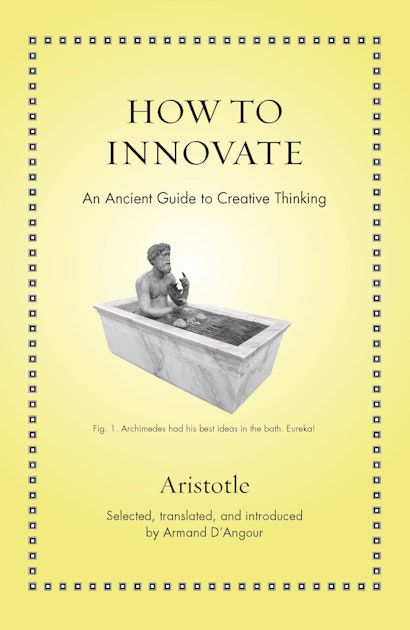When I worked in business in the 1980s I was struck by the constant demand for the new. The company I worked in produced and stocked a wide range of well-designed products for a varied international market, but customers would regularly pass over existing designs—even the most recent ones—and ask “What’s new?” Eventually the company’s overstock of products became a serious problem. I suggested that we simply give new names to current ranges and present them in a new product catalogue. This proved a great success; customers complimented the company’s “exciting new ranges”, and sales took off. It made me wonder what it really meant for something to be “new.”
Novelty in presentation was not all the company needed to think about. New technologies, new production sources, new organisational systems, new personnel, new design protocols—all had to be negotiated, examined, and embraced. The process felt both exciting and alarming, and I wanted to know whether a similar ambivalence had always been felt about ‘the new’, particularly in eras when novelty was a conspicuous phenomenon. As I was schooled in classical history, the first period that came to my mind in this regard was that of classical Greece.
In the course of five centuries from around 800 to 300 BC, Greeks were faced by intellectual and cultural novelties of enormous and—though they were not to know it—lasting consequence. These novelties included the use and spread of the first true alphabet (the vehicle of Greek writings and subsequently of all Western thought), the first appearance of democratic politics and a monetised economy, the earliest notions of philosophy, logic, evidence-based historiography, mathematical proof, theatrical drama, and empirical medicine, and new waves of thinking and experimentation in art and architecture, music and science, warfare and religion.
The Greeks’ accomplishments have sometimes been spoken of as ‘the Greek miracle’, but they did not achieve their innovations by magic or by accident. They understood what innovation involved and applied themselves to creating the new. Can their manifold experience help us to understand innovation in general? Can we apply the lessons and principles of the distant past to our own projects in order to be more innovative?
The Greeks were well placed to borrow ideas from nations to their east and west, and one key principle that emerges from the study of ancient innovation is that the new always builds on the old. There is no such thing as truly ‘radical innovation’ i.e. novelty that has no roots in or connections to the past: all innovation is an adaptation of something that already exists. As the philosopher Parmenides (fifth century BC) argued, ‘Nothing comes from nothing’; logically, we cannot have any understanding of or connection to something that is wholly detached from prior experience.
The corollary is that, if one wishes to innovate, one needs to know the background against which one seeks to produce something new. This highlights the importance of knowledge, education, and inquiry, and it’s no coincidence that the period of the Greeks’ most notable attempts at innovation saw the rise of schools, writing, and forms of secondary education. An educated, informed populace with the resources to disseminate and criticise existing knowledge enjoys a firm base on which it can seek to innovate.
Analysis of the Greeks’ experience of novelty, for which some classic and entertaining narratives may be found, shows how strategies such as the cross-fertilisation of disparate ideas, disruption and reversal, or adaptation and “tweaking”, are key mechanisms of the innovative process. Unconsciously or consciously applied, these represent constant structures of creative thinking which in myriad combinations and permutations allow innovators to create what is recognised as new.
The acceptance of what is new, however, is as much a matter of psychology as of external reality. ‘O brave new world that has such people in it’, exclaims Miranda in Shakespeare’s Tempest, on seeing young men for the first time on her magical island. ‘’Tis new to thee’, Prospero replies. For the young woman the novelty is an objective attribute of the world; for Prospero it’s a function of his daughter’s youth and ignorance.
Innovators generally don’t seek to do something radically new. They use strategies such as the transferring a technique from one context to another or making incremental improvements to a product. If the recipients of their innovations are not familiar with what they present—however well known these are in other instances—the result will be a perception of something new. An example might be the transition to democracy by a nation that has not hitherto enjoyed democratic rights; though the political principles will be well known elsewhere, they will feel like an innovation to that society.
Aristotle, the most comprehensive thinker of the ancient world, examined both the logic of change (in Physics) and its social ramifications (in Politics). The latter explores innovative ideas in legal and constitutional arenas. “Is political change a good thing?” Aristotle asks. Can one invent new laws or new ways of running a state, as if creating a new product or a work of art? Aristotle pertinently observes that innovation means different things depending on the area in which it is applied, and that political innovation is in a different category from technical innovation. Following Aristotle’s lead, innovators and investigators of novelty are bound first to analyse the particular context in which they are operating, and to consider such questions as “What does ‘new’ mean in this area? What sort of innovation is required here?”
Innovation is a dynamic process, involving an active interchange between individual innovators and the public, tradition and change, old and new. The pluralistic environments which foster the pursuit of innovation generate diverse responses. Freedom, competition and incentive are widely recognised as key conditions of innovation. The ancient Greeks were no strangers to these notions. After all, they invented the notions of democracy and freedom under the law and the first large-scale monetary system; and they were notoriously competitive—so much so that constant warfare between city-states led to the eventual dissolution of Greek pluralism, as the Hellenic world was subsumed into the empire of Alexander the Great. Military imperatives generally have the effect of diverting such creativity to destructive outcomes; but creative thinkers have often—in a standard innovative manoeuvre—been able to apply military inventions to peaceful purposes.
The new takes the place of the old; and since this is sometimes bound to mean the loss of real value, societies should also consider when not to innovate. The modern world has little time for reflection about the destruction that innovation can entail. But if today’s ceaseless innovation—from new technology and political change to new art and music—brings anxiety as well as excitement, we can acknowledge that in this respect at least there is nothing new under the sun. The pressure to innovate will not abate, and in today’s urgent circumstances of pandemic, climate crisis, and political turmoil, positive innovation is needed more than ever. An anatomy of classical Greek innovation, with its fund of entertaining and illustrative histories, offers valuable insights into the timeless operations of creative thinking.
Armand D’Angour is Professor of Classics at the University of Oxford. His book The Greeks and the New was published in 2011. How to Innovate: An Ancient Guide to Creative Thinking is due from Princeton in October 2021.

